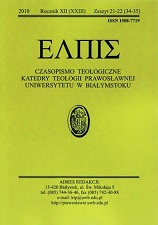Krótka historia Prawosłanego Autonomicznego Kościoła Świętej Góry Synaj
Short history of Autonomous Church of Holy Mountain Sinai
Author(s): Doroteusz SawickiSubject(s): Christian Theology and Religion
Published by: Wydawnictwo Uniwersytetu w Białymstoku
Keywords: Sinai Peninsula; St. Catherine’s Monastery; Orthodoxy; Autonomous Church; Burning Bush of Moses; St. John Climacus; Codex Sinaiticus
Summary/Abstract: The Holy Mountain Sinai was known and venerated in the Old Testament. On this mountain, Moses saw God in the form of a burning bush and heard His name – Jahwe (I am, who I am). When returning from bondage in Egypt, Moses received the ten commandments on stone tablets and instructed Israel. Also, the Prophet Elijah hid himself from the wrath of Queen Isabel on Mount Sinai. In the times of the New Testament, the caves of Sinai became a dwelling place for Christian recluses in the III century. After the relics of St. Catherine the Martyr were found on the top of Mount Sinai, anchoritic monasticism began to give way to monastic communities. The first church was built by St. Helen here in the IV century, and later in the VI century, a monastery was established by the Emperor Justinian. The monks of this monastery, such as St. John Climacus and St. Gregory of Sinai, significantly contributed to the development of Christian teaching and asceticism. The monastery on Mount Sinai engaged itself in the theological debates of this time, fighting against monotheletism and iconoclasm. Mount Sinai did not lose its importance when the Arabs and later Turks occupied the whole Sinai Peninsula. In the VII century, the Monastery of St. Catherine was made the seat of the bishop of Pharan. In the IX century, it was raised to the honour of archbishop. The diocese was made into an autonomous Church by the Patriarch of Constantinople in 1575. Although Sinai was canonically dependant on Jerusalem, it was granted much independence. The Church safely survived both world wars and Israeli-Egyptian conflicts. Although the Church in Sinai consists of the fewest people in any local church, its importance still remains. The icon collection is the richest in the world, the archives and library is second largest in the world and the Codex Sinaiticus of the Holy Scriptures is a world treasure. The relics of St. Catherine and the Burning Bush of Moses also give loftiness to the image of the Autonomous Church of Sinai.
Journal: Elpis
- Issue Year: 2010
- Issue No: 12
- Page Range: 365-386
- Page Count: 22
- Language: Polish

